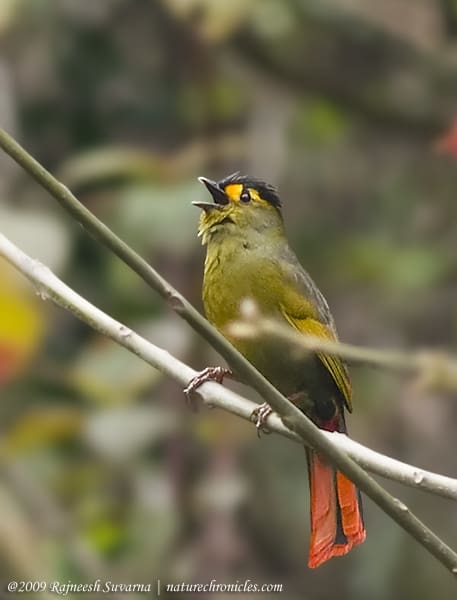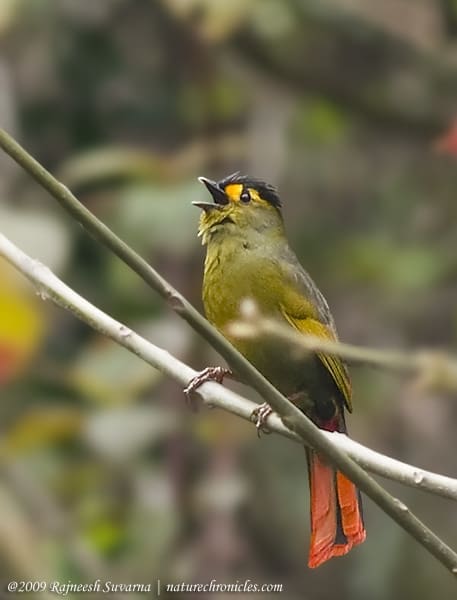
As we headed out of Guwahati airport towards Eaglenest Wildlife Sanctuary in Arunachal Pradesh, the Bugun Liocichla (Liocichla bugunorum) was on our minds. Though none of us mentioned it (since no one wanted to be thought of as a twitcher), every one of us was hoping to catch a glimpse of India’s latest new bird discovery, described in 2006 after its first sighting in 1995 at Eaglenest.
Bird discovery is not commonplace in India — the last bird reported was the Rusty-throated ‘Mishmi’ Wren-babbler (Spelaeornis badeigularis), also in Arunachal Pradesh, in 1948.
Ramana Athreya, a birdwatcher and astronomer at the Indian Institute of Science Education and Research, Pune, had sighted a pair of colourful liocichlas (a species of old-world babbler) in 1995 but had to wait for 10 years for another sighting. Sketches showed a babbler very close to the Emei Shan Liocichla (Liocichla omeiensis), which is known to occur in China with the nearest record being 1000 km away. Mist-netting in May 1996 (a delightful storytelling session at the camp later would yield a sidenote that the first mist-netted specimen was accidently released since the captor could not hold the precious twitching bird while the photo session was in progress) yielded detailed measurements and plumage description and a rare new species was added to the incredibly rich biodiversity of Arunachal. It’s also only the fourth Liocichla to be known — the Red-faced Liocichla (Liocichla phoenicea) is common in Southeast Asia (we later saw it at Eaglenest) and other than the Emei Shan Liocichla, the only other liocichla species — Steere’s Liocichla (Liocichla steerii) — occurs in Taiwan.
We decided to take our first chance of sighting the bird on the very first day of our visit. That gave us a backup in case we didn’t manage a sighting, a very likely scenario given that only 14 birds are known, including three pairs, one of which we were hoping to sight.
Shashank Dalvi, an avid birder, wildlife researcher and our guide, knew of a location beside the main road that services the Lama Camp. The location was sort of a narrow ravine almost like a crack in the mountain. It had a few small trees and bushes – in fact, it was degraded habitat by Eaglenest standards. As we waited with bated breath, Shashank played the bird’s call. After a few tense moments the birds responded, yet did not appear. They were very close, flirting about in the shrubbery, and were quite vocal now. After a brief rest (in order to prevent call fatigue, as I learned later) the call was replayed. Suddenly a bird appeared along a horizontal branch of a small tree right in front of us. While we looked at it greedily, and Rajneesh went ballistic on his Sony DSLR, the second bird appeared. Then onwards it was pure birding bliss. The birds vocalized, got cozy, flirted and, best of all, completely ignored us for the next 15 minutes.
This medium-sized babbler has a general olive-gray aspect, a prominent black cap and a bright orange lore. The underside of the tail is orange (see photograph) and the upper side is blackish. The breast has a yellowish flush, sort of olive-yellow, while the olive on the back is somewhat suffused with grey. The beak is small and black and the eyes are black with no eye ring. There are patches of golden-yellow, crimson and white on the wing and the secondaries are tinged with crimson at the edges.
The Bugun Liocichla is stunningly beautiful and, coupled with its rarity, it is a huge draw for the ecotourism project at Eaglenest. The project is run by the Bugun tribe, which owns the forest where the bird was discovered. Their community is contiguous with the Eaglenest sanctuary. Athreya chose to name the bird after the tribe (he could have named it after himself) with respect for a community that has zealously guarded the forest and chooses to preserve it for future generations.
We often sighted the tribe’s warm and affable headman, Mr Indi Glow, along the main road that cuts through the forest and the sanctuary (this is the only road for now, maintained by the Bugun community, and it is also the route that the Dalai Lama took on his escape into India in 1962). He always had a small backpack and a pair of binoculars, more proud of birds and the forest than in the money he could possibly have by letting in wood contractors.
We stayed there a long time, rooted to the spot beside the dusty road along the ravine, oblivious to the rich birdlife around us. It was as close to celebrity bird-watching as one can get, and after the sighting, my friend Atul prostrated and kissed the hallowed ground.
It is quite likely that future surveys might yield new populations of this bird but it is very unlikely that it will ever become common. A paper by A Townsend Peterson and Monica Papes mentions that “suitable areas extend into neighboring Bhutan and China. Of particular interest for future searches would be the areas of Bomdilla, Dengan La, and between Poshing La and Lagam, as these are relatively extensive areas that apparently match the ecological profile of the sites where the species was encountered.”
Meanwhile the Eaglenest population is all that we know of and, while the bird is lucky to be in a protected area, habitat conservation remains critical for its continued survival.
References:
A new species of Liocichla (Aves: Timaliidae) from Eaglenest Wildlife Sanctuary, Arunachal Pradesh, India
Potential geographic distribution of the Bugun Liocichla Liocichla bugunorum, a poorly known species from north-eastern India, A Townsend Peterson and Monica Papes
The Green Ogre thanks the ace photographer Rajneesh Suvarna for the use of his image of the Bugun Liocichla (shot at Eaglenest Wildlife Sanctuary, Arunachal Pradesh in April 2009). Rajneesh’s images can be seen at NatureChronicles.
Text by Sahastrarashmi
Latest posts by SR (see all)
- Encounter: The Sacred Grove at Oorani - November 28, 2012
- Encounter: Rhododendron, sentinel of the highlands - October 7, 2012
- Manjhi Akshayavat, an immortal Banyan tree - July 17, 2012

